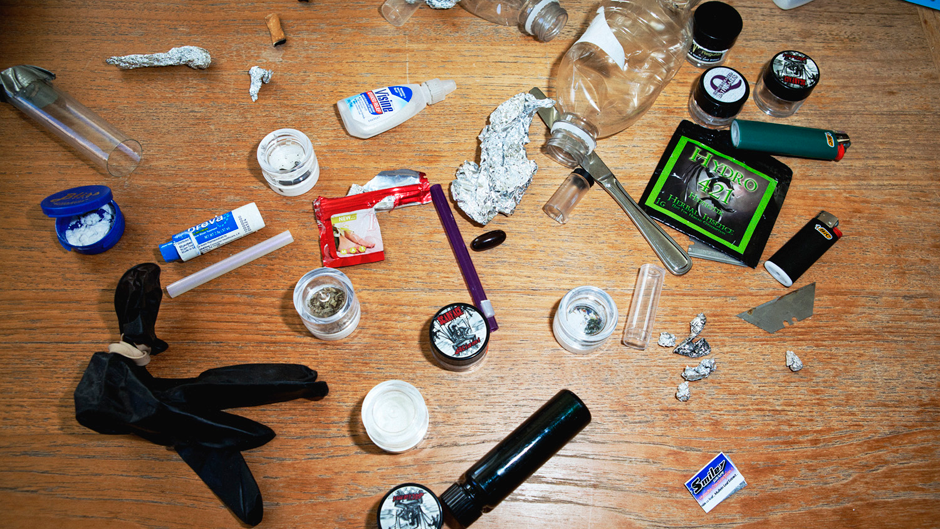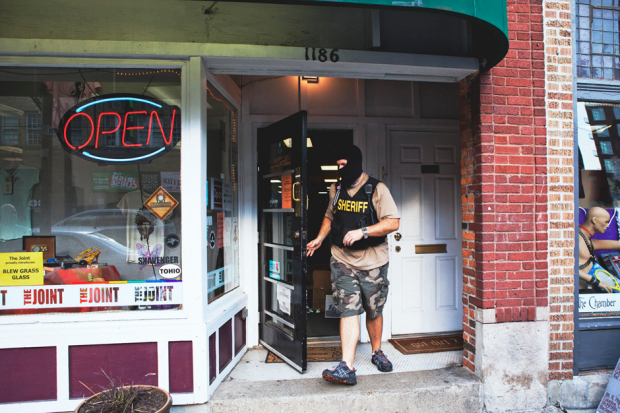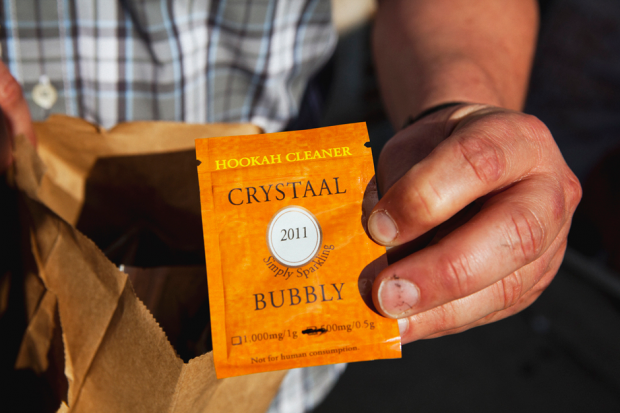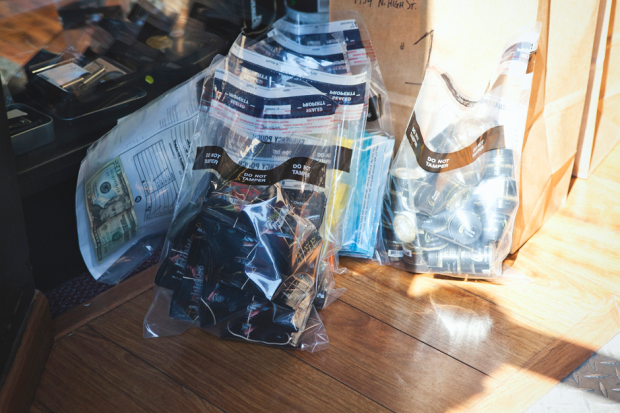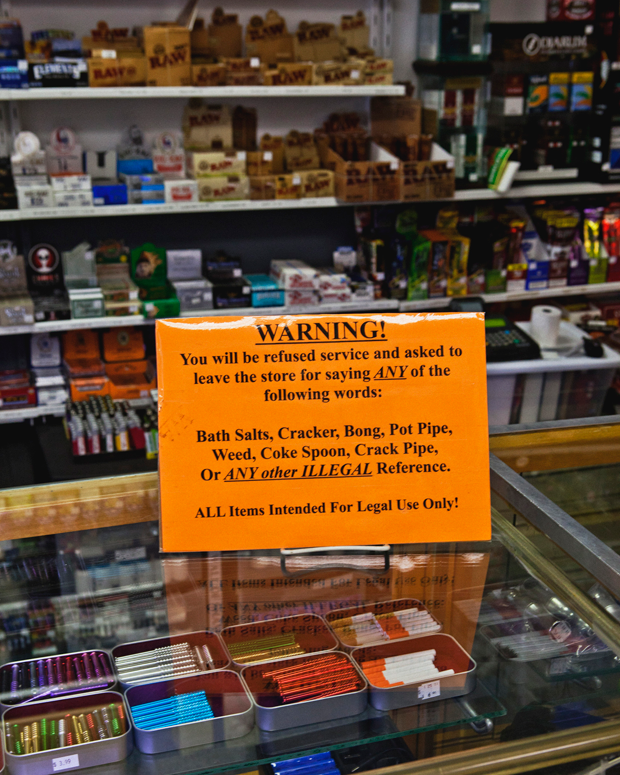COLUMBUS, OH — On an unseasonably hot and muggy May afternoon, a squad of armed agents from the Franklin County Drug Task Force — some wearing street clothes, some wearing menacing ski masks — swarms into a storefront aptly named the Joint. Sandwiched between a liquor store and a sex shop, and adjacent to the Ohio State University campus, the Joint is one of 18 different head shops, gas stations, carryout restaurants, and mini-marts being searched this day by seven task force teams consisting of several dozen officers from numerous local police departments and prosecutors’ offices, all spearheaded by the County Sheriff here in the state capital.
Make no mistake: This is no ordinary pot bust. The raids are part of the ongoing Operation Synthetic Drugs, a highly coordinated and choreographed sweep through central Ohio. The target of this operation — which has received assistance from the DEA and the FBI — is a strand of a relatively obscure but insidiously metastasizing illegal substance marketed under the name “bath salts,” a deceptively innocuous moniker used to disguise the drug as a benign household product.
As small knots of sweaty tweakers gape from across the street, visibly frustrated that one of their favorite haunts is being hit, the law-enforcement troops inside the Joint hit pay dirt. After a meticulous, two-and-a-half-hour ceiling-to-floor toss, the cops emerge with a bulging Hefty bag and cardboard cartons brimming with $70,000 worth of synthetic marijuana known as Spice and what they assume to be bath salts, the latter being sold in little foil packets. By the time night falls, the task force teams seize $250,000 in illegal synthetic drugs in the greater Columbus area. Selling and possessing bath salts in Ohio is a felony, yet due to loopholes in state and federal laws, the anonymity of the Internet, and the pace at which the chemicals can be altered, prosecuting anyone above a street-level seller and buyer currently poses a stiff challenge.
About two years ago, bath salts — a lab-brewed drug that unpredictably mimics a freakish combination of coke, meth, and Ecstasy — suddenly popped into public consciousness with a rat-tat-tat of reports from emergency rooms and law-enforcement officials that sounded like the stuff of a D.A.R.E. officer’s most florid nightmare. By most accounts, the drug — then legal — first surfaced in Louisiana in mid-2010, quickly moved through the South, and then spread out in all directions. It was, in fact, in Louisiana where one of the first Code Red warnings about bath salts emerged, when a user lost her arm and part of her shoulder after she shot herself up and sparked a flesh-eating bacteria.
Not all drugs are created equal. Unlike, say, meth, bath salts transcend class. They most often establish a beachhead in college towns where head shops tend to cluster. To generalize, there are two types of users: college-age kids who want to get high without engaging in criminal activity and just plain drug addicts looking for a hassle-free fix.
In some sense, bath salts are an exercise in decriminalization. Buying drugs, especially hard narcotics, is often a seedy experience: You have to go to dangerous areas to obtain them, make the transaction with active, often violent, criminals, and then sweat at stoplights, hoping to make it back home without a felony possession charge. But the way the synthetic drug market currently exists, you can walk into a climate-controlled shop, slide your ATM card under the glass, and walk out. Or you can skip all that and just order online. The casualness of the purchase, the sterilization of the exchange, is part of what makes bath salts so pernicious and appealing. And the ease with which key chemical compounds can be disseminated, and thus adjusted to stay one step ahead of the law, ensures that the drug stays decriminalized.
The last four decades have seen plenty of whipped-up hysteria about various fad intoxicants of the moment. But the fear generated by bath salts seems well earned. Dr. Mark Ryan, director at the Louisiana Poison Center, called bath salts “the worst drug” he has seen in his 20 years there. “With LSD, you might see pink elephants, but with this drug, you see demons, aliens, extreme paranoia, heart attacks, and superhuman strength like Superman,” Ryan has said. “If you had a reaction, it was a bad reaction.”
Starting in late 2010, an influx of violent, irrational, self-destructive users began to congest hospital ERs throughout the States. A 19-year-old West Virginia man claimed he was high on bath salts when he stabbed his neighbor’s pygmy goat while wearing women’s underwear; a Mississippi man skinned himself alive while under the influence. Users staggered in, or were carried in, consumed by extreme panic, tachycardia, deep paranoia, and heart-attack symptoms. (Perhaps the most infamous incident tied to bath salts is Rudy Eugene’s horrific naked face-eating attack in Miami in May, although conclusive toxicology reports have yet to be released; still, the fact that this feels like the closest thing to a credible explanation for chewing a homeless man’s head for 18 minutes speaks volumes about the drug’s reputation.)
Because the chemicals most often found in bath salts — mephedrone, methylenedioxypyrovalerone, and methylone — were not outlawed initially, a nearly year-and-a-half period ensued where, to the horror of law enforcement, salts were sold legally and widely, not only in head shops, but in gas stations and convenience stores all over the U.S. In 2010, 304 calls were made to poison control centers nationwide regarding bath salts. A year later, the calls skyrocketed to 6,138.
Bath salts being sold over the counter, in stores, carry names like Cloud Nine, White Ivory, Vanilla Sky, Purple Wave, Panic, and Rushmore. Salts peddled online come branded with harder-edged names like White Slut Concentrated, Scarface, and, yes, “Charley Sheene.” Bath-salt packets are usually marked with the disingenuous warning Not For Human Consumption in an attempt to skirt drug laws and to throw off customs agents. DEA officials believe that the base compounds are manufactured primarily in China and India and then imported into the U.S., where traffickers cut and mix the drug in a variety of ways — just one of the reasons why even the first hit of salts can produce unpredictable results.
“Some of these manufacturers will mix these substances purposefully or not purposefully,” says Jeffrey Comparin, a senior DEA laboratory director. “There’s zero quality control. You have no idea what you’re putting in your body.”
Last year, several municipalities moved to ban the drug, and dozens of states have followed suit. In October 2011, the DEA used its administrative powers to institute an emergency but temporary one-year ban on the three basic bath-salt chemicals, declaring them Schedule 1 substances. Possession can now lead to a four-year federal felony sentence.
But the clock is ticking. The DEA’s ban runs out this fall and a federal bill to make it permanent had been stalled in the Senate, mostly thanks to libertarian true-believer Sen. Rand Paul (R-KY), before finally passing on May 24 (two days before, the bill was also opposed by groups such as the Drug Policy Alliance, which argue that stiff legislative penalties will only escalate a futile War on Drugs).
Cops working at the ground level disagree and fear bath salts could become a devastating epidemic, as crack did in the ’80s and meth in the following two decades. “It’s tempered since the ban, but not nearly enough,” says Lt. Shawn Bain, a narcotics agent with the Franklin County Sheriff’s office, who is coordinating the Ohio raids. “What the ban did was force bath salts to go underground.” You can’t straight-out ask for bath salts in shops anymore, Bain says. But that doesn’t mean they’re not on shelves or that users don’t know how to ask for them in coded terms.
The race to stem the tide of bath salts is underlined by daily reports of busts from Maine to New York to Arizona and Nevada. Merely two weeks before the Ohio sweep, 70 police and federal agents targeted three stores, seized 11 properties (plus $750,000 in cash and bank credits), and arrested a suspected kingpin distributor. The raid was the culmination of the nation’s largest and longest investigation into bath salts.
In the two months prior to the Ohio raids, undercover agents in Franklin County made 38 different bath-salt buys. A number of those purchases were made at the Joint on North High Street in Columbus. The day before the Ohio raid, I stopped by the Joint to see if police claims that bath salts could be purchased there easily were true.
Inside the spacious head shop, the room-length glass counters were covered with glass pipes, vaporizers, dubious sexual-enhancement pills, and four signs that read: “Warning! You will be refused service and asked to leave the store for saying any of the following words: Bath Salts, Cracker, Bong, Pot Pipe, Weed, Coke Spoon, Crack Pipe, or any other illegal Reference.”
I linger at the counter looking for any of the other easily recognizable names that bath salts are sold under: Potpourri, Plant Food, Jewelry Cleaner. Nothing. I do see tiny jars of synthetic marijuana, packets of Crystal Bubbly hookah pipe cleaner, electronic cigarettes, and dick-shaped bongs. I ask for a pack of Marlboros and leave, wondering what, if anything, the cops are going to seize the following day.
Turns out the bath salts were there right under my nose. Unlike the tweakers, I didn’t know the street code necessary to make the buy. When the Task Force agents emerged from the Joint 24 hours after my visit, they brought out 2,300 packets, all of them wrapped in bright orange, lightly disguised as hookah cleaner — the Crystal Bubbly I had seen earlier.
“I’m not surprised,” Bain tells me on the way to the next raid in southern Columbus. “This stuff is still everywhere,”
he says. “We just made a dent today.”
This story originally appeared in the July/August 2012 issue of SPIN, which you can order here now.

